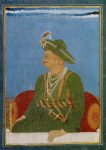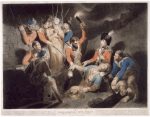 A cache of more than 1,000 18th century artillery “rockets” has been found in the village of Bidanuru in the Shimoga district of Karnataka, southwestern India. Workers found the early shells while digging out an abandoned dry well. The iron cylinders used by the King of Mysore, Tipu Sultan, to fight against the British forces that would, after his death, conquer the subcontinent, were recognized by the diggers as the king’s rockets and archaeologists were called in to the excavate them.
A cache of more than 1,000 18th century artillery “rockets” has been found in the village of Bidanuru in the Shimoga district of Karnataka, southwestern India. Workers found the early shells while digging out an abandoned dry well. The iron cylinders used by the King of Mysore, Tipu Sultan, to fight against the British forces that would, after his death, conquer the subcontinent, were recognized by the diggers as the king’s rockets and archaeologists were called in to the excavate them.
“Excavation of the open well led to unearthing of over 1,000 corroded rockets that were stored during Tipu’s times for use in wars,” R Shejeshwara Nayaka told Agence France-Presse from the site, 240 miles north-west of the state capital, Bangalore.
“Digging of the dry well where its mud was smelling like gunpowder led to the discovery of the rockets and shells in a pile.”
It took three days for the 15-member team of archaeologists, excavators and labourers to unearth the armoury and ammunition.
 Tipu Sultan came to throne already in a state of war against the British. His father Haider Ali had fought them off an on (mainly on) since 1767, and after his death from cancer on December 7th, 1782, Tipu Sultan picked up where Haider Ali had left off fighting the Second Anglo-Mysore War. His success on the battlefield forced the British to sue for peace in 1784, the last time they would come to the treaty table as supplicants in India.
Tipu Sultan came to throne already in a state of war against the British. His father Haider Ali had fought them off an on (mainly on) since 1767, and after his death from cancer on December 7th, 1782, Tipu Sultan picked up where Haider Ali had left off fighting the Second Anglo-Mysore War. His success on the battlefield forced the British to sue for peace in 1784, the last time they would come to the treaty table as supplicants in India.
Tipu was known as a strong warrior from an early age. His father, keenly conscious of his own illiteracy, had ensured his son had the very best education, particularly in military matters, available. French officers in the employ of Haider Ali tutored his son in arms and combat and they were apparently damn good at it. Tipu first accompanied his father on campaign, the invasion of Malabar, when he was 15. By the time he was 16, he was commanding cavalry corps and competently, no less.
Haider Ali began using iron rockets in the 1780s — he had more than a thousand men in his rocket corps — but it was in the Third Anglo-Mysore War (1790–1792) that Tipu Sultan turned it up to eleven, increasing his rocket men to 5,000, developing the iron-encased artillery shell to peak power and precision and pioneering its use in mass rocket attacks against the British East India Company and its Indian allies.
 Measuring around 10 inches long, the enclosed iron tubes were filled with gunpowder and tied to the end of a bamboo shaft. That made them portable and compact enough to be launched by an individual soldier. The black powder combusted inside the iron chamber and acted as a propellant to give the shells lift and reach. Some would burst in the air at the target; others would bounce on the ground until the charge was spent.
Measuring around 10 inches long, the enclosed iron tubes were filled with gunpowder and tied to the end of a bamboo shaft. That made them portable and compact enough to be launched by an individual soldier. The black powder combusted inside the iron chamber and acted as a propellant to give the shells lift and reach. Some would burst in the air at the target; others would bounce on the ground until the charge was spent.
Mysorean rockets were significantly more accurate and nimble than European artillery. Their range was over a mile and they could be aimed with great precision. European rockets weren’t made of iron and so were not strong enough to stay intact and contain the combustion of the powder so they had a more limited reach. They were the first iron-encased rockets to be successfully deployed in combat and indeed were so successful that the British took note, using them as the prototype for their own foray into the iron rocket business, the Congreve rockets developed by Sir William Congreve in 1804 and immediately put to use in the Napoleonic wars.
 Some of Tipu Sultain’s rockets have been unearthed before near the current find site, but never in so great a number. Tipu, whose father had conquered Karnataka in 1763 and absorbed it into the Kingdom of Mysore, appears to have used the spot as a hidden weapons depot to use against British forces in a pinch. It was not enough to save his kingdom or his life. Tipu Sultan died on May 4th, 1799, while valiantly defending his fort of Srirangapatna during the Fourth Anglo-Mysore War. The British victory was decisive, ending the Kingdom of Mysore, installing puppet princes from the feudal dynasty Haider Ali had ousted who reigned in name only until India became an independent republic in 1947.
Some of Tipu Sultain’s rockets have been unearthed before near the current find site, but never in so great a number. Tipu, whose father had conquered Karnataka in 1763 and absorbed it into the Kingdom of Mysore, appears to have used the spot as a hidden weapons depot to use against British forces in a pinch. It was not enough to save his kingdom or his life. Tipu Sultan died on May 4th, 1799, while valiantly defending his fort of Srirangapatna during the Fourth Anglo-Mysore War. The British victory was decisive, ending the Kingdom of Mysore, installing puppet princes from the feudal dynasty Haider Ali had ousted who reigned in name only until India became an independent republic in 1947.
The cache will be conserved and displayed in a “rocket gallery” in the Shivappa Nayaka Palace Museum in Shivamogga city, a palace built, as it happens, by Haider Ali, even though it bears the name of the Nayaka dynasty he overthrew.